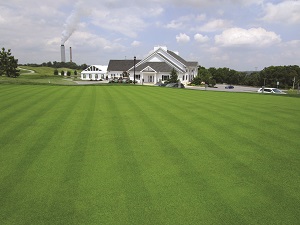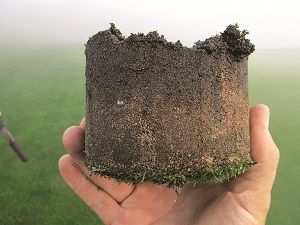How I survived when my greens didn’t
After soil contamination wiped out his greens in 2015, a superintendent learned to control what he can control.
The alarm would ring at 4 a.m., but it didn’t matter because I regularly sat on the edge of my bed for most of the night staring at the wall.
This happened most nights in May 2015 as my greens slowly died. I didn’t know how to stop it. During my second full year as superintendent of Royal Manchester Golf Links in York, Pa., I encountered an issue with my greens. They didn’t recover after aerification in early May. At the beginning of June, I realized they were dying because of a contaminated chemical unknowingly released to our industry and applied on my greens.
That year was a journey of emotions. I hope that the many key lessons I learned can help other superintendents who go through the loss of turf at some point in their careers. Some of these keys include faith, communication, camaraderie, work ethic and fear management.
I will now be much better prepared when issues arise, and it’s my desire that superintendents learn from my story so we all can succeed in this business.
Trouble 10 days out
After having a great 2014 season and seeing rounds and reputation rising for 2015, I tried to remain humble, knowing how quickly things can turn from great to bad. Unlike most of my local superintendent brethren, we had no winter injury on greens that spring. Having faith in God and choosing to be humble allowed me to start on a better footing as I entered the most difficult situation of my professional career.
The greens were healing nicely 10 days after aerification. It was time for a light PGR and fertility application, along with what I will refer to as “Fungicide X.” Three to four days after that application I noticed that we were still picking up sand when we mowed and we weren’t getting much grass. By May I was thinking that we had gotten a little sting from the fertilizer or PGR, even though everything was at low rates.
I tried using small amounts of other fertilizers to help the grass push out of the sting. The color of the greens started looking darker, almost water-soaked, a kind of Pythium look, but that wasn’t it. I then started seeing small patches of turf beginning to grow and have dew on them in the morning. I thought to myself, “Well, that’s not right.”
I sent turf samples to two local labs. One said that it was severe disease and the other said it was a different disease. I also sent a soil sample to my soils lab, trying to rule out things. I sprayed the required chemicals, and three days later the greens looked worse than ever. My heart sank — I was out of bullets.
A few days, later a local salesman told me that some other courses were having similar issues with Fungicide X. When I heard this, the pieces started to come together. I was absolutely relieved that there was another explanation. I slept better that night than I had for the entire month. There was lots of work ahead, but it was freeing to finally have some direction and to know it wasn’t just something I missed along the way.
No judgment, just help
I initially relied on my experience and education but quickly realized that this was not a battle meant to be fought alone. I always had admired the camaraderie of gentlemen in this business, so I shelved the phrase “I’ve got this” and invited local superintendents, consultants, trusted salesmen and others to my course.
I suppose my reaching out could have been interpreted as welcoming judgment, but I knew that pride could have no part in solving this problem. If I wanted to be completely solution oriented, I needed the help of more experienced people, and not just for turf questions, but also to remain emotionally stable enough to get this resolved.
I was more pleased than I ever could have imagined when people rallied with me, not to point out faults, but to help for the sake of helping. And the help didn’t just come from outside. My assistant, Chad Krebs, was influential in consulting with me and always remaining positive, even when I wasn’t. Many assistants know turf, but to find one who truly assists in all facets — including emotional support — is a blessing that Chad brings to Royal Manchester.
I knew I had to communicate with people through this process, even though everything in my body told me to stay away as much as possible. A bright spot during this trial was the continued support of my general manager, Kieron Mooney. Keeping him current on everything allowed us to work together to solve this issue. Open lines of communication and absolute honesty permitted Kieron to not only make wise decisions, but to shoulder some of the burden as we went through this together. Communication at home is just as important as at work when it comes to helping us be better superintendents and people.
My wife, Jen, doesn’t know a great deal about turf, but she was instrumental in helping during the quiet times when I wasn’t looking at roots under a microscope or trying to remain a strong leader of my crew. At one point she sweetly said to me, “What is the worst thing that can happen here?” I thought for a moment and said that the greens would completely die and I would lose my job. Then she said with a small smile, “Then what would happen?”

Practice green grown-in 35 days after seeding. (Photo: Jesse Hartman)
With a small sigh of relief, I said I would find another job and continue to support our family. She is so wise. She was not belittling my job or our profession, just kindly helping me manage fear. Fear is not an option for a successful leader.
This line of thinking led me to write a simple list. On one side of the list were things I could control, and the other listed things I could not. This simplified the situation because I found many things that were in my thoughts that I had no business thinking about. I could not control them.
Against the odds
When I found out about the contaminated chemical I may have slept a little better, but I was far from completing the year’s emotional journey. We had in the neighborhood of 90-percent turf loss on greens. It was in planning the recovery that opinions started to relentlessly roll in. Earlier ideas had helped identify the problem, but I now had to guard against too many opinions and make the best decision for Royal Manchester.

Practice green profile with new turf and roots. (Photo: Jesse Hartman)
My confidence was trashed by this time, but my wife’s sweet words rang true again in my spirit, so I recommended against all odds that we reseed our greens into our current organic mat in June, as opposed to rebuilding our greens completely or sodding them. This decision was backed by a consulting group with which we do regular business.
I now had a grow-in situation on my hands — something which I had never done — on a non-ideal seedbed and during the toughest months of the year. There were even some people boldly telling me that it wouldn’t work. However, I knew the property, and I knew it was the right call for our situation. The research, planning, thought processes and consulting were finished. It was now time to move on.
This process involved growing greens in the toughest part of the summer in arguably the toughest grass-growing region in the country, the mid-Atlantic Transition Zone. June was extremely wet, but we fortunately didn’t have severe thunderstorms right after seeding, so there were no seed washouts. The wet June helped the seed germinate. We had a couple of heat waves with temperatures in the mid to upper 90s as summer pressed on, but these subsided more quickly than in years past, so the weather helped rather than hurt. We are accustomed to high humidity in the summer, with temperatures at times reaching the low 100s.
It’s funny to think that the turf really did recover well, and by all standards somewhat quickly. It just didn’t seem to happen quick enough for me. It seemed as though we were never going to get back to the great surfaces we once had. But we pressed on, making one decision at a time about when to start mowing, topdressing, fertilizing, etc.
One great thing about the situation: I had an opportunity to use different products and observe the turf’s response. With grow-in fertility being so high, I believed we weren’t really getting the bang for our buck, so I added a granular humate product to the rotation. We weren’t spraying at this point yet, and contrast was stunning. We got a much better response from our fertility after we added in the granular humate.
Our goal was to re-open the course by October for the York Open, which is our largest event of the season. We ended up having a full recovery going into the fall, with plans to open to the public in the spring of 2016.
Looking forward
The young greens came through this winter extremely well. Roots are healthy again and the shoots are transitioning into their summer green. It feels great to get back to what I know best. But surviving last year has put much more in my troubleshooting arsenal for the next turf mystery.
The major keys I’ve learned through the year’s emotional journey:
- Start with a strong faith in God.
- Solid communication.
- A strong work ethic in knowing I am and will continue to do the best work I can for Royal Manchester.
- Consider things that I can control and leave the rest where it belongs, out of my mind.
- Lean on wise counsel.
In the fall of 2015, the greens had fully recovered and Jen and I welcomed the birth of our first child, Simon Joseph. Whatever difficult situations we encounter in our jobs and as people, just know that there will always be better times in the future. It would do us all well to think consistently on the good things in life.
Jesse Hartman, a graduate of The Ohio State University’s Turfgrass Science program, is the superintendent of Royal Manchester Golf Links in York, Pa. This year is his 17th in the industry.
Photos: Jesse Hartman








